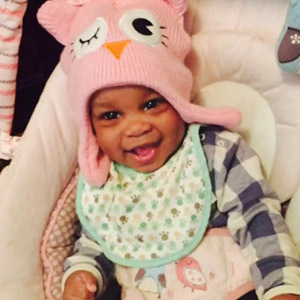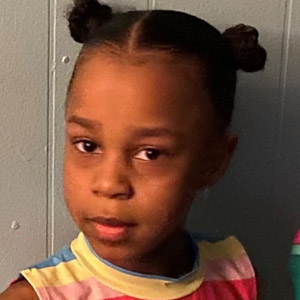Everyone is always so nice, understanding and professional. Our therapists have been great. Anybody whose child has been diagnosed with autism and doesn’t know where to go – CSH is the place to be!

Journee Robinson was hitting milestones, walking, and talking as she neared her first birthday in 2016. “She was able to sing her ABC’s and count from one to 10. She would say ‘mama,’ ‘dada,’ and even her sister’s name,” shares Donna Branch, Journee’s mom. “Journee could pick up a can of ginger ale and drink it without a problem or any help. All of a sudden, I saw a change.”
Donna shares that she would try to engage Journee in singing the alphabet song and she would just look at her and smile. “Something was changing and I knew something wasn’t right.” When she brought Journee in for her yearly wellness visit in 2019, her concerns grew as she was filling out paperwork. “I had to fill out a sheet before the appointment that notated Journee’s development; was she speaking in sentences or saying certain words? Could she walk up and down the stairs? All of these milestones were listed and I wasn’t able to check off many of them. Journee could walk and jump, but her vocalization had stopped and she wasn’t drinking from a cup or straw like she had been able to previously.”
After speaking with Journee’s doctor and discussing her concerns, Donna reached out to Children’s Specialized Hospital (CSH) to schedule a full evaluation. After a plethora of observations and tests including hearing tests, Journee was diagnosed with Autism and referred to outpatient occupational and speech therapy at CSH’s Hamilton outpatient center.
COMING TO CSH
 Journee started occupational therapy and speech therapy in 2020, during the height of the COVID-19 pandemic. Donna shares that she never had the opportunity to go to her sessions in person because the pandemic hit and everything went virtual. “Journee even started Kindergarten virtually and would have school from 8:00 am to 2:00 pm, then she would be back online at 4:00 pm for therapy,” shares Donna. “It was a little challenging for her to stay still and focused, but I tried to get her engaged and she did get used to the schedule. Having the telemed option was really incredible, especially when I went back to work as things began opening back up.”
Journee started occupational therapy and speech therapy in 2020, during the height of the COVID-19 pandemic. Donna shares that she never had the opportunity to go to her sessions in person because the pandemic hit and everything went virtual. “Journee even started Kindergarten virtually and would have school from 8:00 am to 2:00 pm, then she would be back online at 4:00 pm for therapy,” shares Donna. “It was a little challenging for her to stay still and focused, but I tried to get her engaged and she did get used to the schedule. Having the telemed option was really incredible, especially when I went back to work as things began opening back up.”
Journee started with her occupational therapy sessions initially, then began incorporating speech therapy with speech language pathologist, Laura Rogers.
“When I first started with Journee, I spoke with mom about building engagement,” shares Laura. “I talked about taking a step back and focusing on working toward those pre-communication skills (gestures, facial expressions, imitation, joint attention and visual regard). We worked on expanding her play skills initially to help find out what motivates Journee. Mom was open to work with me from the beginning.”
“I have to say, I really loved Laura and was dreading when our sessions would be over. She was really great,” shares Donna. “She’s very knowledgeable and the tools she provided were very effective and we saw positive changes. At first it was hard for Journee to stay put and focused and engaged, but we were doing things at home, following what Laura gave us during sessions, and it was great to see progress.”
 As therapy progressed, Laura worked together with Donna to continue encouraging Journee to practice requesting items using picture exchange for communication. “I sent a list to Laura of Journee’s favorite things that would motivate her during sessions, like Cheerios, bubbles, oranges, music, a toy, etc.,” says Donna. “During sessions we would take out these picture cards Laura had made of the items and see if Journee could hand us the pictures to request what item she wanted. Laura and I both had tears in our eyes because she picked it up so quickly.”
As therapy progressed, Laura worked together with Donna to continue encouraging Journee to practice requesting items using picture exchange for communication. “I sent a list to Laura of Journee’s favorite things that would motivate her during sessions, like Cheerios, bubbles, oranges, music, a toy, etc.,” says Donna. “During sessions we would take out these picture cards Laura had made of the items and see if Journee could hand us the pictures to request what item she wanted. Laura and I both had tears in our eyes because she picked it up so quickly.”
Laura adds that this picture technique is a helpful tool for children not just for requesting things, but also to teach a child how to initiate with a communication partner, help the child expand beyond single words and pictures, use language for a variety of pragmatic functions (i.e., requesting, responding, commenting, etc.) and ultimately allows therapists to gain a better understanding of what the child comprehends, especially when they aren’t communicating with words yet.
Donna continues to share that a huge part of what made her telemed therapy experience so successful was how the entire family was encouraged to get involved. She has two older daughters and her middle daughter would also sit in on the sessions to see what Laura was doing with Journee so she could help continue those lessons while at home. “Laura doesn’t just care about the child but cares about parents and families and shows empathy because this journey can be tough.”
“It was amazing working with this family. In almost every session one of Journee’s older sisters participated and that really helped Journee make the progress she did because we could work on generalizing the skills she was learning to different communication partners,” shares Laura. “It was also incredibly helpful to have the sessions occur via telehealth. There are so many pros that I don’t think people realize to completing sessions via telehealth; the child is in their most comfortable environment, it allows us to really coach the parents to be our hands (which really helps with carryover at home), and it allows us to use exactly what the family has in the home for our therapy sessions. For Journee and her family, it really allows us to use things that the family has immediate access to and assisted in thinking creatively with what was already in the home.”
SHOWING CREATIVITY
Donna shares that one obstacle she has seen Journee overcome thanks to her therapy sessions is her level of engagement. “Getting Journee to stay engaged and understand what we’re saying to her, making that eye contact were huge for us! The positive reinforcement from therapy that we’ve continued outside of therapy has also helped. Journee would get excited and then continue to get more involved because she was so enthused.”
Outside of therapy, Journee is a typical five year old. She loves Baby Boom and Fancy Nancy. “She has so many Fancy Nancy dolls and DVD’s that she loves to watch,” shares Donna. “She also loves bubbles, blocks and puzzles, and drawing doodles on her white board. Journee is also extremely affectionate and loves to give her family hugs and kisses.”
SHARING HOPE
When asked what advice she would have for families who are going through similar challenges, Donna says that there will be obstacles along the way, but get out there and do your research; join groups and get involved in-person and through social media. “Build those relationships and ask questions. Read other stories, that also helps me to stay encouraged and know Journee is going to be ok. Definitely don’t give up! This is going to be a journey but if you utilize the tools and follow instructions and guidance that the therapists give you, you will see results. And this is coming from me as a single parent. Laura would tell me about events that were hosted by CSH and recommend ones that she thought I should go to. It doesn’t hurt to peek in and check it out, especially because some of the doctors and therapists are there participating, giving information and answering questions.”
“I had started to prepare myself before Journee’s diagnosis because I saw signs and I wasn’t surprised when the diagnosis was given. I did feel like I wanted to cry, but I didn’t because I was prepared. I’m not in denial but I’m not going to get upset. I think it’s important to not focus on the diagnosis itself, but focus on what I can do to make things better for her. It’s not the end of the world.” Donna continues to say things are not going to happen overnight, but if you put in the work you’ll see the results. “You have to just stay patient – it’s a lot! But I don’t ever complain about what it is I have to do with Journee. I’m hopeful things will improve with this work.”
Ultimately, Donna says her greatest hope for Journee is that she is able to live a productive life and be a productive member of society.
“My greatest hope is that she is able to speak and vocalize what she needs to say to others verbally on her own,” explains Donna. “She’s so smart, she just can’t speak to verbalize what she wants but she can show you and she understands direction. If she hears me start the bath water she knows it’s time for her bath, if I ask her to go get her slippers to put them on, she will, if she wants a snack, she will grab my hand and direct me to what she wants in the refrigerator. I would love for her to get to a place where she can verbalize those things, but something in me knows that she’s going to be ok.”
Journee was recently discharged after six months of therapy and having met all her goals. She is planning on returning for another episode of care, but Donna shares they’re not sure if that will be in-person or virtually yet. “I told Laura, only half-jokingly, that when we are scheduled to return we will wait for her if she’s not available. I said, we need to have you back!”
Donna continues, “I love working with CSH and I don’t think there’s been a time where I’ve worked with someone or come in contact with someone and didn’t have pleasant experience. Everyone is always so nice, understanding and professional. Our therapists have been great. Anybody whose child has been diagnosed with autism and doesn’t know where to go – CSH is the place to be!”